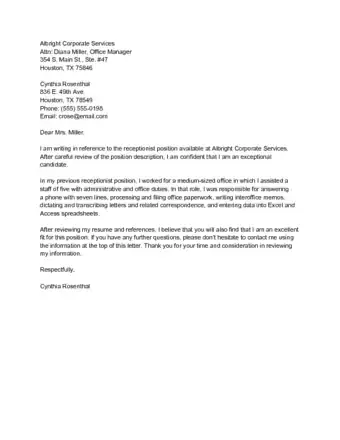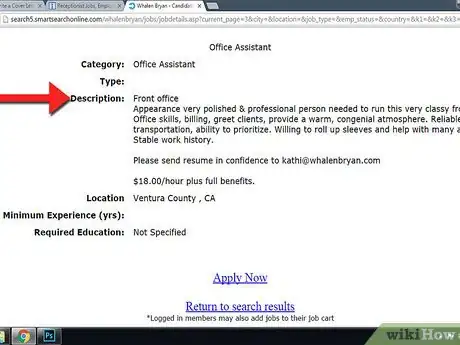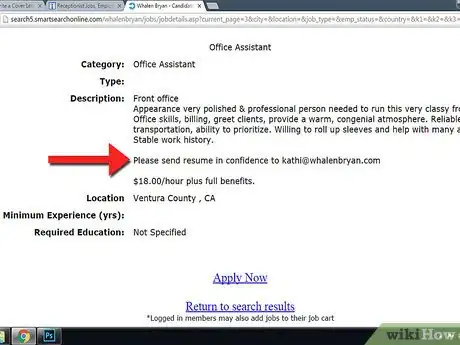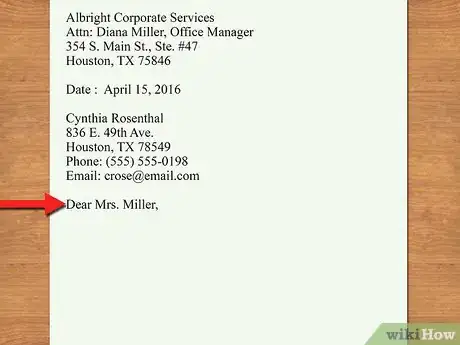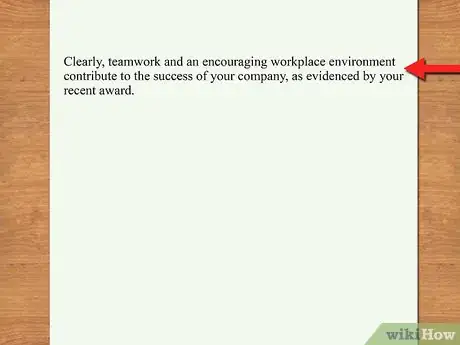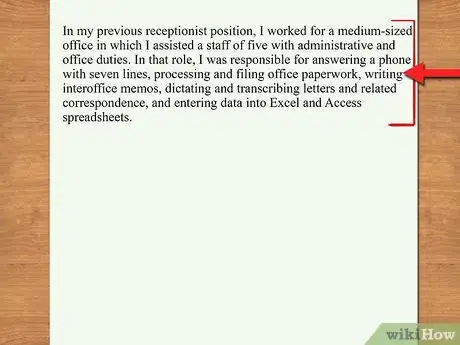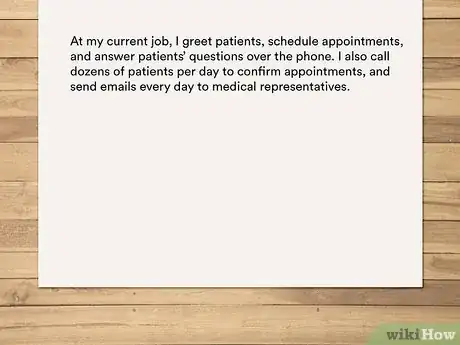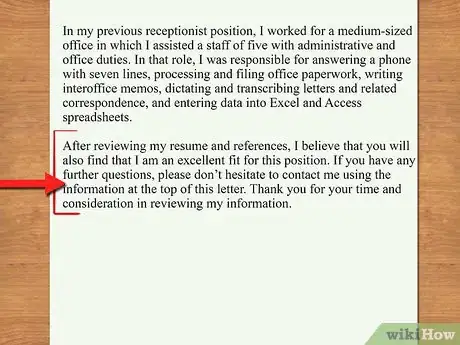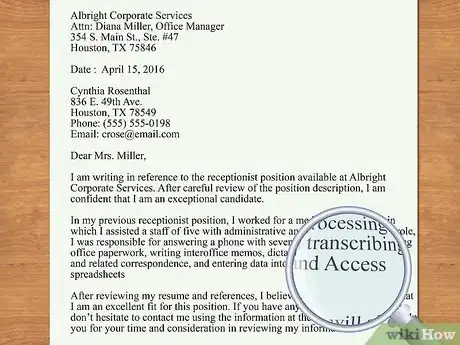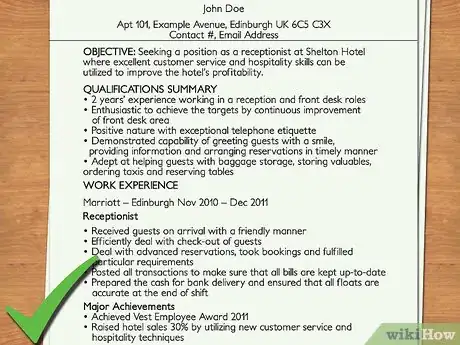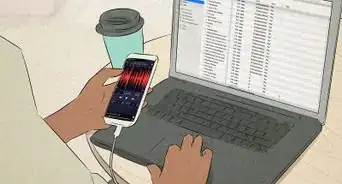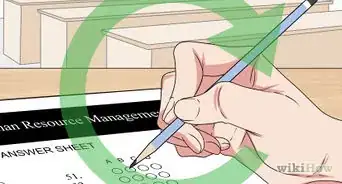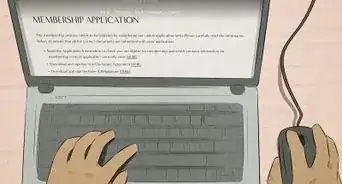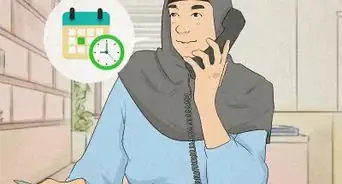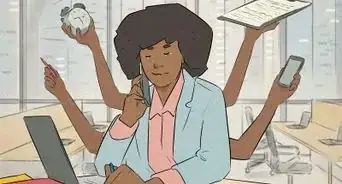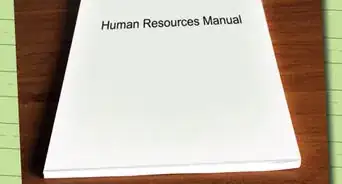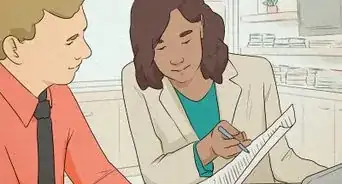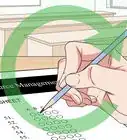This article was co-authored by Kolby Goodman. Kolby Goodman is a Career & Job Search Coach and the Founder of The Job Huntr. With over eight years of experience, he specializes in resume edits, interview preparation, LinkedIn profile feedback, and professional interview coaching. Additionally, his career advice has been featured in publications such as The Huffington Post. Kolby holds a Bachelor’s degree in Economics from San Diego State University.
This article has been viewed 153,098 times.
Receptionists serve as the first line of contact between a company and its visitors, so the job is very important. A job as a receptionist is ideal for candidates with great organizational and interpersonal skills. If you think this would be a good career choice, your first step is writing a great cover letter. With a little bit of work, you can put together a cover letter that will grab the attention of potential employers and help you get the receptionist job you want.
Steps
Sample Cover Letter and Template
Gathering Information
-
1Read the job posting carefully. When writing your cover letter, you should make reference to the original job posting. To prepare for this, make sure you know the job posting well.[1] [2]
- Look at the job description and pick out the duties that you have experience or skill with. Pick only the top two or three skills that are relevant to the job posting. Prepare to address these skills in your cover letter.
- Do the same with the qualifications section of the posting. Pick out your qualifications that match those of the job, and make note of them so you can state them in your letter.
-
2Confirm who to send the cover letter to. Most job postings will include a name and address of the representative you should contact about the job. Be sure to copy this down correctly: one wrong number in an address will send your cover letter to the wrong place, and spelling the representative's name wrong will hurt your chances right from the start.[3]Advertisement
-
3Investigate the company. In addition to reading the job posting carefully, you should do some research into the company at large. That way, you can use information about the company in your cover letter. This will demonstrate that you're a dedicated candidate and can increase your chances of getting the job.[4]
-
4Learn the format for a business letter. All cover letters should be considered formal business letters, including one for a receptionist position. This applies whether you're sending an email or a hard copy letter. Learn this format and use it for all your cover letters.[5] Become familiar with the following format and be sure to use it when writing your letter.
- Place your name, title, and address on the top left of the paper.
- Place the date below this.
- Put the person's name, title, and address below this.
- Address the person appropriately. Start with "Dear Mr." or "Dear Mrs."
- Have 1-inch margins around the paper and use single spacing. Don't indent, just use a double space in between paragraphs.
- Use an easy-to-read font such as Times New Roman or Arial, in 12-point font.
- End with "Sincerely," then leave 4 lines so you can manually sign your name. Below this, type your name and title.
Writing the Cover Letter
-
1Address the recipient properly. Remember that this is a formal business letter. You should address the recipient as Mr. or Mrs. Also use "Dear" as a greeting; "Hi" or "Hello" are not appropriate for a business letter.[6]
- If you're unaware of the recipient's gender, then use the person's full name after "Dear."
-
2State why you're writing the letter. Cover letters are very "cut to the chase" kinds of letters. A long greeting is unnecessary. The first paragraph is for announcing your purpose, so you should state right from the top why you're writing this letter.[7]
- The opening sentence should read something like: "I am writing with interest in the receptionist position at your company." When actually writing the letter, make sure to name the company.
- If someone at the company recommended that you apply for the position, mention him or her here. In this case, the opening sentence would read: "I am writing with interest in the receptionist position at your company that John Smith recommended to me."
-
3Introduce yourself to the recipient. After the first sentence, within the first paragraph, you should give a very brief introduction of yourself. This shouldn't go longer than two sentences; just give the recipient an idea of who your are.[8]
- A good introduction would be: "I am a recent graduate of New York University, where I majored in business."
-
4State your interest in the job. After you've introduced yourself, start the next paragraph. The first part of the body of your letter should be why the company interests you. This shows that you've done your homework in investigating the company and will show the potential employer that you're a dedicated candidate.[9]
- Mention exactly what the company does, and why these activities interest you. Don't be afraid to compliment the company here -- a little flattery can help break the ice with a potential employer.
-
5Lay out your qualifications. The rest of the body section of your letter should present your qualifications to the company. Use this opportunity to spell out exactly why you're a perfect fit for this job.[10]
- Address specific parts of the job posting. This shows that you've done your work, and will also display your qualifications in a nice, succinct way for the recipient.
- Mention your past experience and how it will suit you for this job. Here is a good opportunity to elaborate on some points on your resume that don't get fully covered on the resume itself. For example, a past internship is only a quick entry on your resume, but perhaps you gained invaluable skills on it that will make you a perfect fit for this job. Mention that here.
- Specifically, you should focus on customer service and computer experience. Receptionists work on the computer and interact with people every day, so this experience is crucial.[11]
-
6Talk about how you've been able to help improve customer retention or how you've been commended for your attentiveness and your response to customer issues. Get specific, because the employer is looking for somebody to solve the right problems.
-
7Restate your enthusiasm for the job in the conclusion. After stating all of your relevant experience, start a concluding paragraph. In this paragraph, you should reiterate your enthusiasm for the job and that you are a qualified candidate. Also thank the recipient for his or her time in considering your application.[12]
- Your closing should sound something like this: "As you can see from my qualifications, I am an ideal candidate for this position. I greatly look forward to hearing from you and speaking further. Thank you very much for your time and consideration."
-
8Proofread your letter. Never send in a cover letter without proofreading it first. Any spelling or grammar mistakes will hurt your application and make you look unprofessional. Always go through your letter at least 2 more times before sending it in. If possible, have someone else read it as well. A fresh set of eyes could catch mistakes that you missed.[13]
-
9Send your resume with your cover letter. Don't forget to attach your resume when you send your cover letter. If you don't send your resume, it's almost certain that the potential employer won't answer your cover letter. For help with resumes, read Make a Resume.
References
- ↑ http://www.forbes.com/sites/susanadams/2011/03/24/how-to-write-a-cover-letter/2/
- ↑ https://writing.wisc.edu/Handbook/CoverLetters.html
- ↑ https://writing.wisc.edu/Handbook/CoverLetters.html
- ↑ http://career-advice.monster.com/resumes-cover-letters/cover-letter-tips/5-simple-steps-to-a-successful-cover-letter-hot-jobs/article.aspx
- ↑ http://www.letterwritingguide.com/request.htm
- ↑ https://writing.wisc.edu/Handbook/CoverLetters.html
- ↑ http://career-advice.monster.com/resumes-cover-letters/cover-letter-tips/5-simple-steps-to-a-successful-cover-letter-hot-jobs/article.aspx
- ↑ https://writing.wisc.edu/Handbook/CoverLetters.html
- ↑ http://career-advice.monster.com/resumes-cover-letters/cover-letter-tips/5-simple-steps-to-a-successful-cover-letter-hot-jobs/article.aspx
- ↑ https://writing.wisc.edu/Handbook/CoverLetters.html
- ↑ https://administration.myperfectcoverletter.com/receptionist-cover-letter-sample/
- ↑ http://career-advice.monster.com/resumes-cover-letters/cover-letter-tips/5-simple-steps-to-a-successful-cover-letter-hot-jobs/article.aspx
- ↑ http://www.papercheck.com/proofreading.html
